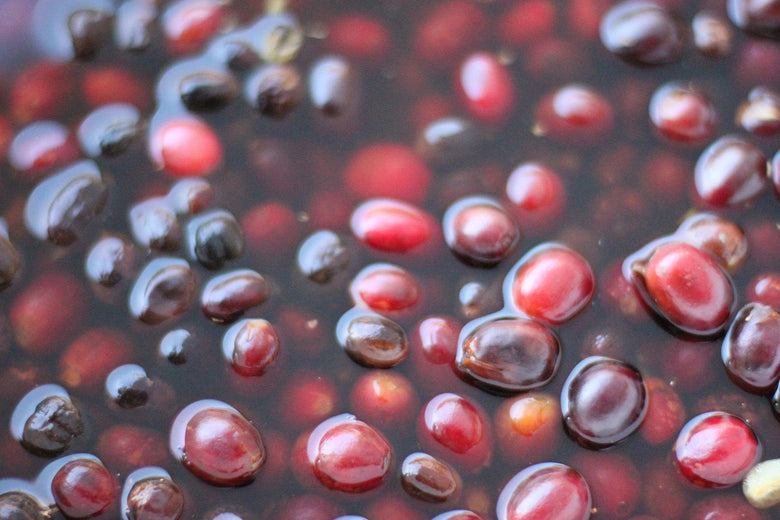Ever stared at a coffee shop menu or website and wondered what “washed process coffee” is? Yeah, I’ve been there too. We all start out a little confused when we look at weird coffee information. However, it’s worth the effort to figure out what you’re reading.
There’s a lot to be gained by learning about the washed process.
Most specialty coffee companies proudly declare how their beans were processed before being roasted, but few companies really explain what the processing methods mean unless you specifically ask.
Read: How To Read Coffee Packaging Like A Pro
Lucky for you, I’m going to break down the whole thing so you can confidently enter your local coffee shop next time around. I’ll show you what the washed process is, why farms use it, and - most importantly - how it affects your coffee’s flavor.
If you can keep the different coffee processing methods straight (there are only 3), you’ll be able to strongly anticipate a coffee’s flavor before you even taste it. It’ll make you a better coffee taster and it’ll make buying coffees more fun (since you’ll know what’s going on).
Want these coffee super powers? Strap in - I’ll give you a tour of the washed process.
Basics Steps Of The Washed Process
The washed process begins like every other coffee process: with a cherry.
The cherries that grow on coffee plants contain two (usually) seeds (actually, coffee beans). The cherries are harvested and sorted. Over and under ripe cherries are separated from the perfectly ripe cherries, which continue on to processing.
Read: The Incredible Journey Of The Coffee Bean
From here on, we’ll go over the basic steps to the washed process. Keep in mind that every washing station has its own little spin on the steps, depending on the needs of the coffee or the climate. Two processes are rarely identical, but they all follow the same general steps.
Pulping, Fermenting, And Washing
Most of the cherry is removed from the bean in this first washed process step. Most often, this happens in a rapidly spinning machine that rips the cherry skin away. Sometimes it happens by forcing cherries through fine grates with water. The separated fruit is typically saved to be used as fertilizer or sold as cascara tea.
Leftover sticky mucilage often sticks to the green coffee beans. This can be removed in the next step.
Ferment-And-Wash
Most mills allow the leftover mucilage to ferment for 12-48 hours. Sometimes this happens in tubs of water (wet fermentation), but sometimes it happens only in the juices of the cherry (dry fermentation).
Fermentation is carefully monitored in this stage. Temperature, time, and acidity are measured multiple times per day to reduce the risk of:
- Sour or off flavors
- Bacteria growth
- Insect invasion
This short fermentation stage is largely responsible for the characteristic acidity and clarity of washed coffees.
Read: 5 Ways To Make Your Coffee More Eco-Friendly
When fermentation is complete, the beans are washed with a round of fresh water.

The Machine Demucilager
Some farms choose to remove the extra mucilage with a new tech: the mechanical demucilager.
With this method, machines scrub the leftover mucilage from the beans with little bristles, rather than allowing fermentation to break it down. The beans are given a quick rinse to remove any leftover mucilage, but it requires very little water.
This method produces less water waste and slightly more predictable results, but it skips that flavor-altering fermentation step.
Drying
The beans are now surrounded by two layers: the silverskin and the parchment. They are now ready to be dried to a moisture content of 10% for safe storage and flavor stability.
Often the beans are spread on large patios or raised beds for days. The beans have to be raked every six hours to discourage bacteria growth and uneven drying.
Sometimes mechanical dryers are used for the entire process. Sometimes these massive machines just finish the job.
And finally, a hulling machine crumbled the dried silverskin and parchment so the baked beans can be shipped around the world.
Read: What Does A Coffee Roaster Actually Do?
This entire process is sometimes referred to as wet processing.
Who Uses The Washed Process?
The washed process is favored in regions where there is plenty of rainfall. The other processing methods (natural, honey) rely heavily on dry weather to work properly.
Since the washed process is shorter than the other processes (5-10 days, compared to weeks), it’s also more predictable and controllable. Simply, there’s less time for things to go horribly wrong. Many farms and mills love the washed process because it produces high-quality coffee with more certainty and consistency than the other methods.
You’ll find washed coffee all over the world, but it’s especially beloved in the South and Central Americas.
What Do Washed Coffees Taste Like?
Washed process coffees tend to have a brighter acidity and lighter body than coffees from other methods.
Read: How To Taste Coffee Acidity
These offerings also tend to have a high level of flavor clarity without a lot of muddiness or cloudiness that blends flavors together. That’s not to say all washed coffees are simple - they can still be fascinatingly complex.
These coffees are consistently delicious, crisp, clear, and insightful.
---
Now that you are familiar with the washed process, you should explore the alternatives: the natural process and the honey processes.
You should also pay attention to the processing method of your coffee. I’m willing to bet your taste buds will agree with what you’ve read here. Trust me, it’s exciting to be able to taste the processing methods.
One great way to learn to taste the differences between processes is to try them back-to-back - and I know just the way to do it.
Images courtesy of Counter Culture Coffee


